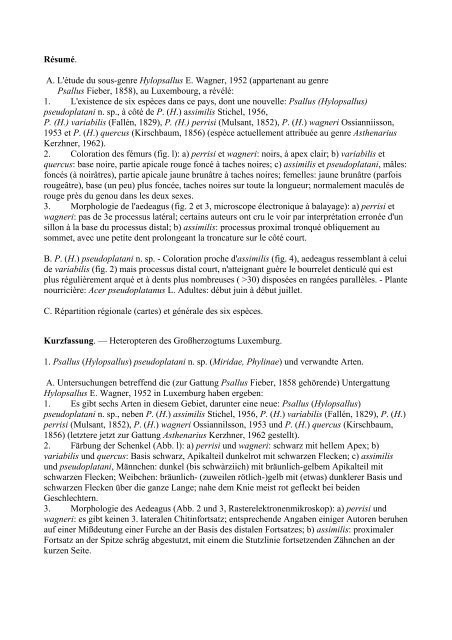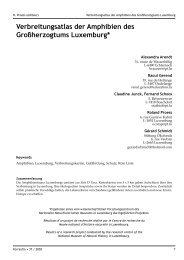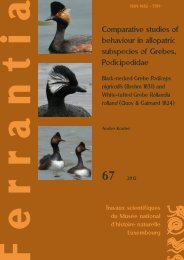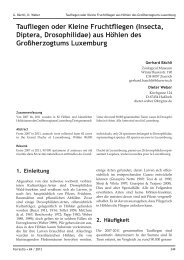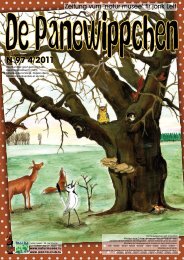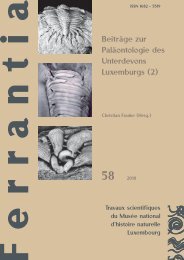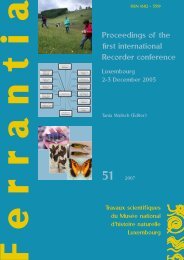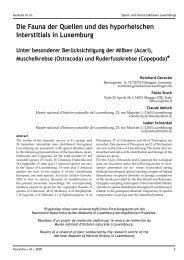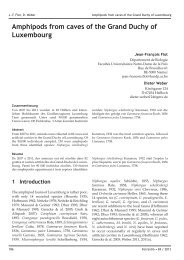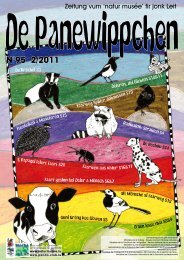Résumé. A. L'étude du sous-genre Hylopsallus E. Wagner, 1952 ...
Résumé. A. L'étude du sous-genre Hylopsallus E. Wagner, 1952 ...
Résumé. A. L'étude du sous-genre Hylopsallus E. Wagner, 1952 ...
Erfolgreiche ePaper selbst erstellen
Machen Sie aus Ihren PDF Publikationen ein blätterbares Flipbook mit unserer einzigartigen Google optimierten e-Paper Software.
<strong>Résumé</strong>.<br />
A. <strong>L'étude</strong> <strong>du</strong> <strong>sous</strong>-<strong>genre</strong> <strong>Hylopsallus</strong> E. <strong>Wagner</strong>, <strong>1952</strong> (appartenant au <strong>genre</strong><br />
Psallus Fieber, 1858), au Luxembourg, a révélé:<br />
1. L'existence de six espèces dans ce pays, dont une nouvelle: Psallus (<strong>Hylopsallus</strong>)<br />
pseudoplatani n. sp., à côté de P. (H.) assimilis Stichel, 1956,<br />
P. (H.) variabilis (Fallén, 1829), P. (H.) perrisi (Mulsant, 1852), P. (H.) wagneri Ossianniisson,<br />
1953 et P. (H.) quercus (Kirschbaum, 1856) (espèce actuellement attribuée au <strong>genre</strong> Asthenarius<br />
Kerzhner, 1962).<br />
2. Coloration des fémurs (fig. l): a) perrisi et wagneri: noirs, à apex clair; b) variabilis et<br />
quercus: base noire, partie apicale rouge foncé à taches noires; c) assimilis et pseudoplatani, mâles:<br />
foncés (à noirâtres), partie apicale jaune brunâtre à taches noires; femelles: jaune brunâtre (parfois<br />
rougeâtre), base (un peu) plus foncée, taches noires sur toute la longueur; normalement maculés de<br />
rouge près <strong>du</strong> genou dans les deux sexes.<br />
3. Morphologie de l'aedeagus (fig. 2 et 3, microscope électronique à balayage): a) perrisi et<br />
wagneri: pas de 3e processus latéral; certains auteurs ont cru le voir par interprétation erronée d'un<br />
sillon à la base <strong>du</strong> processus distal; b) assimilis: processus proximal tronqué obliquement au<br />
sommet, avec une petite dent prolongeant la troncature sur le côté court.<br />
B. P. (H.) pseudoplatani n. sp. - Coloration proche d'assimilis (fig. 4), aedeagus ressemblant à celui<br />
de variabilis (fig. 2) mais processus distal court, n'atteignant guère le bourrelet denticulé qui est<br />
plus régulièrement arqué et à dents plus nombreuses ( >30) disposées en rangées parallèles. - Plante<br />
nourricière: Acer pseudoplatanus L. A<strong>du</strong>ltes: début juin à début juillet.<br />
C. Répartition régionale (cartes) et générale des six espèces.<br />
Kurzfassung. — Heteropteren des Großherzogtums Luxemburg.<br />
1. Psallus (<strong>Hylopsallus</strong>) pseudoplatani n. sp. (Miridae, Phylinae) und verwandte Arten.<br />
A. Untersuchungen betreffend die (zur Gattung Psallus Fieber, 1858 gehörende) Untergattung<br />
<strong>Hylopsallus</strong> E. <strong>Wagner</strong>, <strong>1952</strong> in Luxemburg haben ergeben:<br />
1. Es gibt sechs Arten in diesem Gebiet, darunter eine neue: Psallus (<strong>Hylopsallus</strong>)<br />
pseudoplatani n. sp., neben P. (H.) assimilis Stichel, 1956, P. (H.) variabilis (Fallén, 1829), P. (H.)<br />
perrisi (Mulsant, 1852), P. (H.) wagneri Ossiannilsson, 1953 und P. (H.) quercus (Kirschbaum,<br />
1856) (letztere jetzt zur Gattung Asthenarius Kerzhner, 1962 gestellt).<br />
2. Färbung der Schenkel (Abb. l): a) perrisi und wagneri: schwarz mit hellem Apex; b)<br />
variabilis und quercus: Basis schwarz, Apikalteil <strong>du</strong>nkelrot mit schwarzen Flecken; c) assimilis<br />
und pseudoplatani, Männchen: <strong>du</strong>nkel (bis schwàrziich) mit bräunlich-gelbem Apikalteil mit<br />
schwarzen Flecken; Weibchen: bräunlich- (zuweilen rötlich-)gelb mit (etwas) <strong>du</strong>nklerer Basis und<br />
schwarzen Flecken über die ganze Lange; nahe dem Knie meist rot gefleckt bei beiden<br />
Geschlechtern.<br />
3. Morphologie des Aedeagus (Abb. 2 und 3, Rasterelektronenmikroskop): a) perrisi und<br />
wagneri: es gibt keinen 3. lateralen Chitinfortsatz; entsprechende Angaben einiger Autoren beruhen<br />
auf einer Mißdeutung einer Furche an der Basis des distalen Fortsatzes; b) assimilis: proximaler<br />
Fortsatz an der Spitze schräg abgestutzt, mit einem die Stutzlinie fortsetzenden Zähnchen an der<br />
kurzen Seite.
B. P. (H.) pseudoplatani n. sp. — Fàrbung ähnlich assimilis (Abb. 4), Aedeagus dem von variabilis<br />
ähnlich (Abb. 2), distaler Fortsatz jedoch kurz, kaum den gezähnten Wulst erreichend, welcher<br />
regelmäßiger bogig gekrümmt und mit zahlreicheren Zähnchen ( >30) versehen ist, die in parallelen<br />
Reihen angeordnet sind. — Nährpflanze: Acer pseudoplatanus L. Imagines Anfang Juni bis Anfang<br />
Juli.<br />
C. Regionale (Karten) und allgemeine Verbreitung der sechs Arten.<br />
Summary. — Heteroptera of the Grand-Duchy of Luxembourg. -1. Psallus (<strong>Hylopsallus</strong>)<br />
pseudoplatani n. sp. (Miridae, Phylinae) and Allied Species.<br />
A. The study of the subgenus <strong>Hylopsallus</strong> E. <strong>Wagner</strong>, <strong>1952</strong> (belonging to the genus Psallus Fieber,<br />
1858) in Luxembourg has revealed:<br />
1. Six species exist in this country, one of which is a new one: Psallus (<strong>Hylopsallus</strong>)<br />
pseudoplatani n. sp., in addition to P. (H.) assimilis Stichel, 1956,<br />
P. (H.) variabilis (Fallen, 1829), P. (H.) perrisi (Mulsant, 1852), P. (H.) wagneri Ossiannilsson,<br />
1953 and P. (H.) quercus (Kirschbaum, 1856) (the latter now transferred to the genus Asthenarius<br />
Kerzhner, 1962).<br />
2. Coloration of the femora (fig. I): a) perrisi and wagneri: black, with a pale apex; b)<br />
variabilis and quercus: basal part black, apical part dark red with black spots; c) assimilis and<br />
pseudoplatani, males: dark (to blackish) with brownish yellow apical part with black spots;<br />
females: brownish (sometimes reddish) yellow, (a little) darker towards the base, with black spots<br />
on the whole length; usually red spotted near the knee in both sexes.<br />
3. Morphology of the aedeagus (fig. 2 and 3, scanning electron microscope): a) perrisi and<br />
wagneri: there is no third lateral process, as stated by some authors who misinterpreted a furrow<br />
near the base of the distal process; b) assimilis: the proximal process is obliquely truncate at the<br />
top, with a denticle at the short side.<br />
B. P. (H.) pseudoplatani n. sp. - Coloration similar to that of assimilis (fig. 4), aedeagus<br />
ressembling to that of variabilis (fig. 2), but the distal process is short, scarcely reaching the<br />
denticulate torus, which is more orderly arched and has more numerous ( >30) denticles placed in<br />
parallel ranges. - Host plant: Acer pseudoplatanus L. A<strong>du</strong>lts from early June to early July.<br />
C. Regional (maps) and general distribution of the six species.


